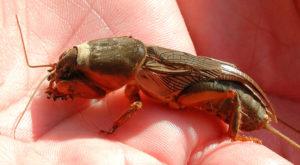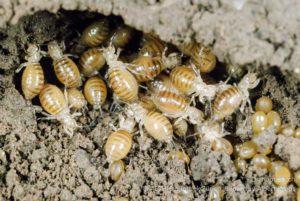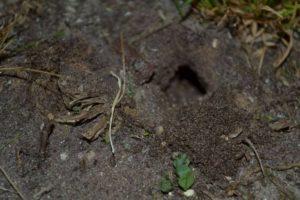What does a bear look like: harmful cabbage and its character
Many insects look unpleasant, if not scary. The leader among unattractive pests, many people will call a bear or a popular cabbage. It is also known under the names top or earthen crayfish.
Content
Description of the bear
Medvedki is a large family, which includes more than 100 species. These are medium to large sized insects that prefer to live underground in burrows.
Insects prefer to dig their passages in moist soil. They have a whole system of moves with separate branches. In summer they are close to the surface of the ground, and in winter they go deeper into the ground.
Appearance
The size of the animal is 5-8 cm. The body is elongated, covered with fine hairs. The front legs are modified, well suited for digging the ground. The pronotum is strongly developed, which simplifies movement.
The color of the bear is usually dark brown, and slightly brightens towards the bottom. Also the limbs. There is a large amount of golden hair on the head and abdomen, which looks like a silk cover.
Diet and distribution
Medvedka lives mainly in the soil that is nutritious and rich in humus. The animal is found throughout Europe and Asia, except for the northern regions with cold winters. Most often they meet a pest in the garden, in the garden or flower bed.
Depending on the species, there are bears that eat certain plants and those that are completely polyphagous. Eats:
- cabbage;
- potatoes;
- corn;
- beetroot;
- tree seedlings;
- herb roots;
- larvae;
- worms;
- self-similar.
Reproduction and life cycle
The insect comes to the surface of the soil in May or June, but only at temperatures above +12 degrees. This is where mating takes place. For laying eggs, the female equips a special room, a nest.
Females are very prolific, can lay 300 to 500 eggs at a time. They are small, dark yellow, covered with a dense shell. Medvedka larvae quickly grow into nymphs that are identical to adults.
Development from a nymph to a full-fledged individual is long - up to 18 months. The adult lives for a year.
caring mothers
Female bears are considered one of the most caring mothers among insects. They build their nest at a depth of 5-10 cm in the ground. This is done with intent, the location allows the nest to warm up well by the sun.
For the same purpose, a cunning female bear destroys all plants on the surface so that nothing blocks the sunlight. The female constantly licks the eggs so that they do not rot.
How does the bear get to the site
When a bear appears on a favorable site, it immediately begins to actively build its communication. She makes horizontal moves under the ground, and vertical ones that are not difficult to notice. The entrance to the burrow is presented as a neat hole and a layer of soil around it.
Medvedka often gets to the site from neighbors. Another way is with manure, which often contains larvae. Often she lives in greenhouses and greenhouses. In the warmth of the night they fly, but do so infrequently.
Natural enemies
The bear itself can be useful. She eats a large number of larvae of the cockchafer.
The pest has many natural enemies. Often they suffer from nematodes that parasitize in the intestines. Also destroy the population:
The biggest confrontation is between the bear and the wasp Lara Anathema. Wasps can penetrate underground passages and expel insects from there. And on the surface, it stings several times in the chest, and the pest dies.
Prevention of the appearance of a bear
There are several ways to reduce the population and avoid the appearance of cabbage on the site:
- Plowing and cultivation, which will allow you to inspect and collect the pest.
- Watering with ammonia. For 10 liters of water you need 10 ml of ammonia.
- Application of carbation soil sterilizer. A 40% solution is prepared and applied in the fall.
Methods of struggle
Medvedka is considered not only the most terrible, but also the most elusive pest. There are several proven methods:
- Poison bait.
- Repellent herbs.
- Special traps.
Full instructions for protecting the site from the bear and how to fight - here to register:.
Conclusion
Bears are dangerous and active pests. They destroy many plants with their vital activity and great appetite. If you do not start the fight in a timely manner, then you can lose the harvest.



